The main Indian battle tank Vijayanta (Vickers Mk.1)
The new tank was supposed to be a relatively light tracked vehicle, in order for the tank to be used in virtually any terrain conditions of a potential customer, its combat weight for the project did not exceed 24 tons. According to the project, the tank was equipped with a 83.8mm caliber gun (they were in service with Centurion tanks) and several anti-tank grenade launchers with a turret in a niche. Grenade launchers were used manually, one by one, the fire was made from the hatch of the tower. The next decision of the designers is the installation of an inexpensive 530 hp engine. Using in the project of a new tank units and assemblies from manufactured tanks, the developers reduced the design time, commercial risk and the final cost of the finished tank.
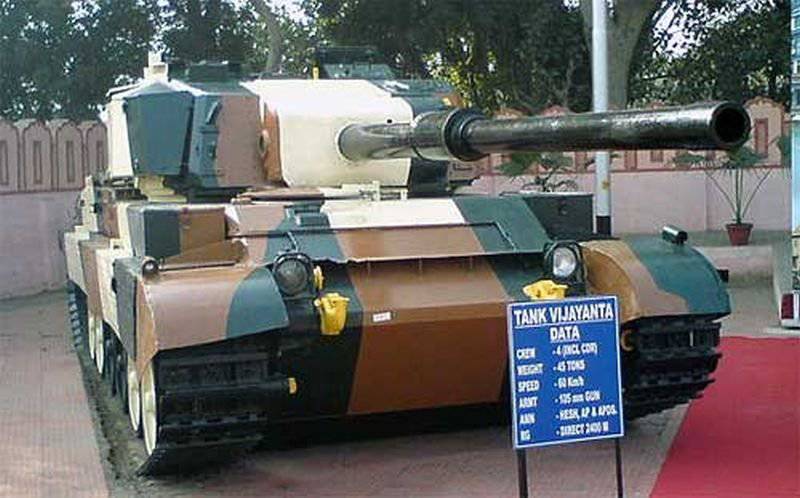
The project turned out to be beautiful and inexpensive, but life has shown that the developers have done a little too much with the savings. Analysis of the use of tracked vehicles has shown that the new tank with a combat mass of 24 tons will not be able to perform the functions of the main tank, due to unreliable body armor, it will also not be able to perform the functions of a reconnaissance vehicle or auxiliary machine, again because of its combat mass, which for these machines is big enough. The use of 83.8mm caliber guns was also considered inexpedient and a proposal was made to replace it with a larger 105mm L7 caliber gun. As a result, the project of a battle tank for a foreign customer was completely revised and the developers started a new project of a battle tank weighing about 40 tons for a potential foreign customer.
The main focus of Vickers Defense Systems at that time was the development of a new tank for the needs of its own army (later “Chieftain”), and the developers of the new project decided to use some of its units in the design of the tank, the main ones being the engine and transmission.
Somewhere in the same period, Indian representatives began negotiations with the company's management on the possibility of creating a new main tank for the Indian army. In 1961, an agreement was concluded, as a result of which Vickers becomes the main developer of a new main Indian battle tank, and the company is helping to build a plant in India for their licensed production.
By 1963, Vickers manufactured the first model of the new tank, and by 1964, the second prototype. The first sample began to undergo factory tests at the company's own test site, the second prototype was sent to an Indian customer to conduct its own tests. In 1964, the Indian military who tested a prototype tank demanded that the developer reduce the combat weight of the vehicle to 38 tons, as the weight characteristics created certain difficulties when conducting tests at Indian test sites.
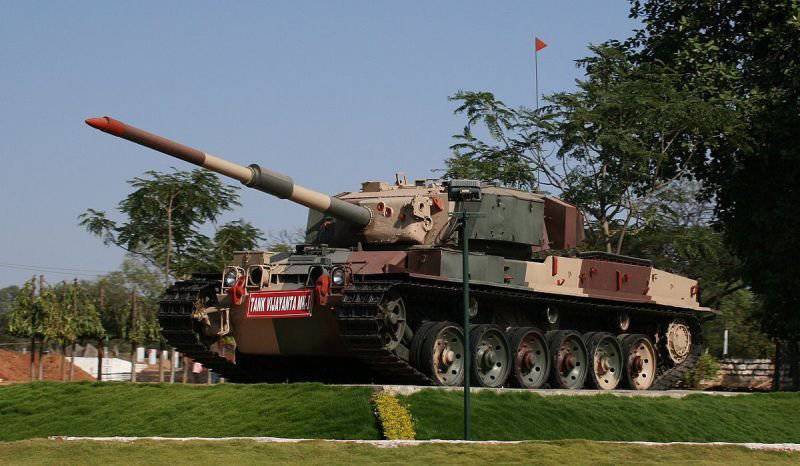
In 1965, Vickers began to supply the first mass-produced main Vickers Mk.1 tanks to India, and from 1966, they launched a factory in Avadi, where they began to produce a new tank under license. At first, the Indian plant only assembled a tank from units and assemblies supplied by Vickers from Europe, and the own production of licensed production tanks became possible after some time, which was necessary for Indian specialists to acquire the necessary experience in the production and manufacture of main tanks. According to reports, tanks "Vickers Mk.1" was released on the order of 1400 units (when needed around 2200). The tanks entered the Indian army under the name “vidjajanta”, which means “winner”. Some of the tanks are still in service, these tanks were at one time a different degree of modernization. The main part of the tanks is decommissioned.
Device and design "Vidjajanta"
The tank is built according to the classical scheme, where the control compartment is made in the front, and the logging system is in the rear of the tank hull. The fighting compartment is made in the central part of the body. The body itself is welded, made of homogeneous steel armor plates. The main difference is the tower part, which is made on the same principle as the hull (in contrast to the similar main tanks of the time). This determined the appearance of the tank tower. Only the mask of the gun was made by casting. Thus, the Vickers company made it possible for third-world countries, where the technology for casting dimensional forms of complex construction was not developed, to produce and manufacture military equipment by themselves.
Driver-mechanic located in the right front side of the case. On the left side was placed ammunition in 25 shells. Driver-mechanic equipment: wide-angle periscope to provide observation and review; passive night vision device for driving at night (installed instead of periscope). When making a forced march or a long movement, the driver-mechanic could block his seat in the most reversed position and control the tank, high leaning out.
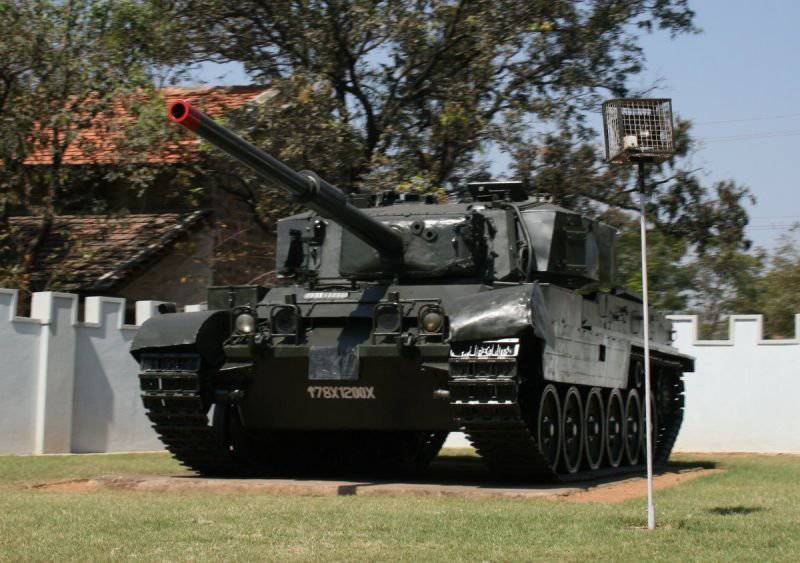
The rest of the crew of the tank (3 man) is located in the tower part provided with a circular rotation. The regular places of the tank commander and the gunner are to the right of the gun loading the left respectively. The tank commander is provided with a commander's turret with 6 periscopes, which provides a full all-round visibility and observation device with an increase in 10-fold. On top of the tower are two hatches, one of which (loader) consists of two halves, which is inherent in the English tank building.
The power plant of the tank is a diesel engine “L60 MK 4В” with the power 720 hp, 6 cylinders, 12 pistons (it was also installed on the main English tank “Chieftain”). But since the Indian main tank has a lower combat mass, the engine experienced less different loads during operation. He provided the tank with a movement speed of up to 48 km / h, and the first prototypes at the test sites showed a maximum speed of up to 55 km / h, which was an unattainable result for British tanks, which, having priority in armor, had a large combat weight. The transmission is made in the same block as the engine. It consists of a main friction clutch, a planetary gearbox at eight speeds (6 forward, 2 back), a tilt mechanism with a triple differential. English tanks were equipped with such transmissions from the 1945 of the year. Individual torsion bar suspension with hydraulic shock absorbers 1,2,6 road wheels. The suspension had full-stroke stops made as small torsions connected with balancers and interacting with the supports. The Indian main tank was the only main tank with this type of suspension.
Suspension - six rubberized twin rollers of the support type, drive wheel mounted in the rear part, guide wheel mounted in the front part of the chassis, three supporting rollers and a track. On the outside of the tracked tracks, 3 rubber pads are installed. The tank is equipped with a special floating equipment, the speed of movement on the water to 6.5 km / h. The caterpillars become the motive force in the water. The standard equipment of the tank also includes a fire extinguishing system. It is possible to install equipment to protect the crew of the tank from the WMD.
Armament "Vidjajanta"
The main weapon of the Indian tank was a rifled 105mm caliber "L7A1". For this purpose, two types of projectiles were created - anti-tank anti-tank projectile and high-explosive projectile equipped with plastic explosive. The initial velocity of the projectile data was respectively 1470 and 730 m / s. The turret is mounted on the sighting 12.7mm machine gun which is used to determine the range. The auxiliary armament includes a machine gun of the caliber 7.62mm paired with the main gun and smoke grenade launchers in the number of 12 units, which are installed on the frontal part of the turret to the right / left of the gun on a block. It is possible to install an additional machine gun on the tower of the tank. The whole tank ammunition consists of:
- 44 shells for the main gun;
- 600 cartridges for sighting machine gun;
- 3000 ammunition for twin machine guns.
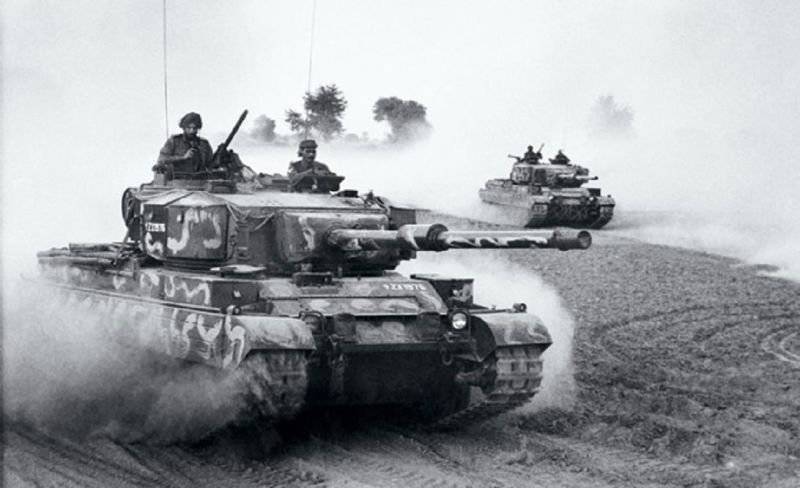
Vickers engineers applied the electric guidance system and the EC517 system for stabilizing the implement in the 2 planes. It was thanks to the stabilization system of the Indian "Vidjajanta" was one of the few tanks of its time, able to fire in motion, and the time required for the production of a shot was relatively small. The developers were proud of the machine that was created, noting that the tank was able to quickly hit several targets, which was practically proven in tests - 10 objects located no more than one kilometer from the tank, Vickers Mk.1 hit less than a minute.
Next development and modifications
The success of the tank "Vickers Mk.1" pushed the developers to continue work on the improvement of the tank. So, after about a year of mass production, it is decided to increase the firepower of the combat vehicle. Two tank launchers with Swingfire anti-tank missiles with a range of up to 4 kilometers are installed on the tank. This modification was called "Vickers Mk.2", but the modification did not enter the mass production - the work on it remained at the level of the prototype. The next modification is Vickers Mk.3, which was developed at the beginning of 1970. It, unlike the previous modification, becomes more tenacious and is launched into mass production. She ordered the Kenyan and Nigerian military, respectively, 76 and 72 main battle tank "Vickers Mk.3".
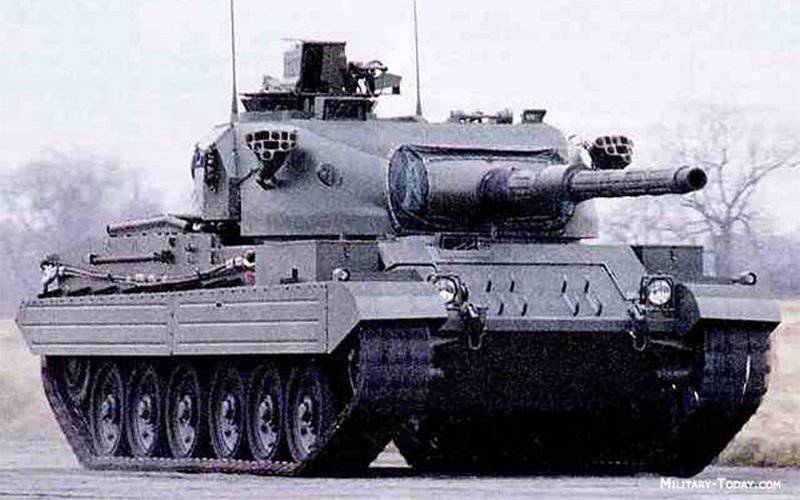
The main differences from the basic modification:
- the tower part was made in a combined way - the whole front part of the tower was made by casting, the rest part was welded from rolled armor plates;
- the tank commander provided a combined aiming device "RE" with 10 multiple times and 4 multiple times at night. The commander gained complete arms control;
- The tank gunner also received a sight with a 10 multiple magnification, as well as a laser-type rangefinder. He could use the way and the commander of the machine;
- The gun received new ammunition: sub-caliber anti-tank with a separating pan and stabilizers; smoke; high-explosive; cumulative;
- the instrument is equipped with new stabilization and guidance systems, as well as with a fire control system;
- installed additional weapons - machine gun caliber 7.62mm, on the tower from the top. Machine gun remote control, vertical guidance angles from 90 to -10 degrees;
- The main ammunition consisted of: 50 shells to the main gun; 700 ammunition for sighting machine gun; 2600 ammunition caliber 7.62mm.
- a new engine is installed in the MTO - 12V-71Т turbo-charged diesel (General Motors) hp 720;
- transmission upgraded to TN12-V5.
The next modification to become "Vickers Mk.3 (I)". It appears in the middle of 1980. The main differences include the following solutions:
- The front part of the body (frontal), cast;
- devices in the control department are assembled into one panel, some have been replaced by more modern ones, several light and sound fault indicators have been added;
- the driver mechanic received two more periscopes, which increased the viewing angle;
- the gun barrel was covered with a cover for thermal insulation;
- the fire control system was expanded by the system of combining the axis of the instrument and the optical axis of the sighting device;
- clean one smoke grenade launcher from each unit;
- the new diesel engine “CV12 TCE” with power 850 hp is installed in the MTO;
- carry out a complete replacement of the transmission - set T1200;
- chassis gets new hydraulic shock absorbers, wide support-type rollers and tracks.
In general, the changes brought the combat mass of the tank to 41 tons, but also made it possible to achieve a higher speed of movement to 59 km / h over a distance of 550 kilometers. A prototype was made at 1986.
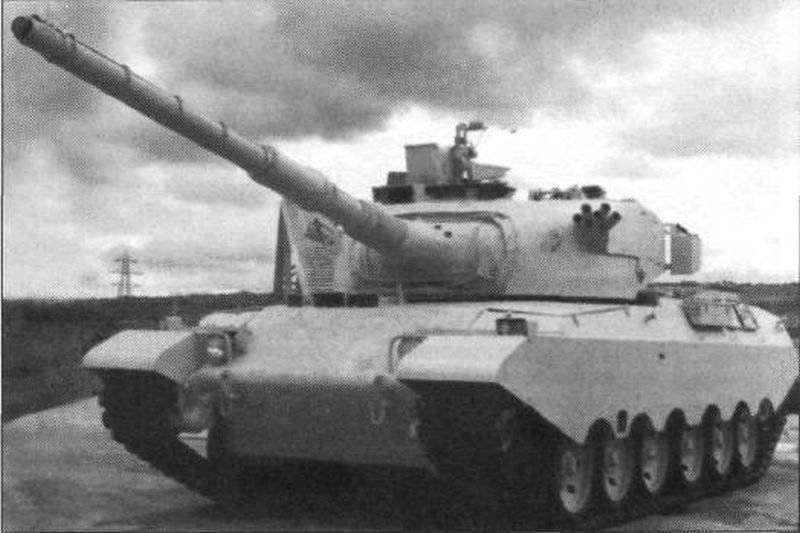
The next modification is "Vickers Mk.3M". It was specially developed for the requirements of the Malaysian army. The main differences are:
- availability of dynamic attachment protection;
- The gunner received a new sighting device (day / night channels);
- installation of a warning system for laser irradiation;
- installation of satellite navigation system receiving equipment;
- improvement of the cooling / air conditioning system;
- made fastening units in the bow of the tank for the installation of a dozer blade.
In 1996, the Vickers Mk.3M demonstrator participated in the tender for the main tank for the Malaysian army.
The main characteristics of the Indian main tank:
- combat weight - 38.6 tons;
- Tank crew - 4 man;
- length with a tool - 9.7 meter;
- width - 3.1 meters;
- height - 2.4 meters;
- ground clearance - 40 centimeters;
- body armor body front / side - 80 / 30-40 mm;
- body armor tower forehead / side / feed - 80 / 40-60 / 40 mm;
- armament: 105mm gun "L7А1"; machine gun M2 sighting caliber 12.7mm; twin machine gun "L8А2" caliber 7.62mm; smoke grenade launchers 2X6;
- ammunition: gun - 44 projectile; 7.62mm - 3 thousands of rounds; 12.7mm - 600 ammunition;
- Power - diesel "160 Mk 4В" power 720 hp;
- maximum speed up to 48 km / h;
- range to 480 kilometers;
- overcome obstacles: wall to 0.9 meter; moat to 2.5 meters; ford to 1.15 meter.
Information sources:
http://dic.academic.ru/dic.nsf/enc_tech/4271/
http://www.thetankmaster.com/english/afv/bmp-1_07r.asp
http://pro-tank.ru/brone-europa/england/348-tank-vickers-mk1-mk3
http://vadimvswar.narod.ru/ALL_OUT/TiVOut9801/VikEx/VikEx003.htm
http://3mv.ru/publ/vooruzhenie_drugikh_stran/tank_vidzhajanta_indija/13-1-0-9098
Information